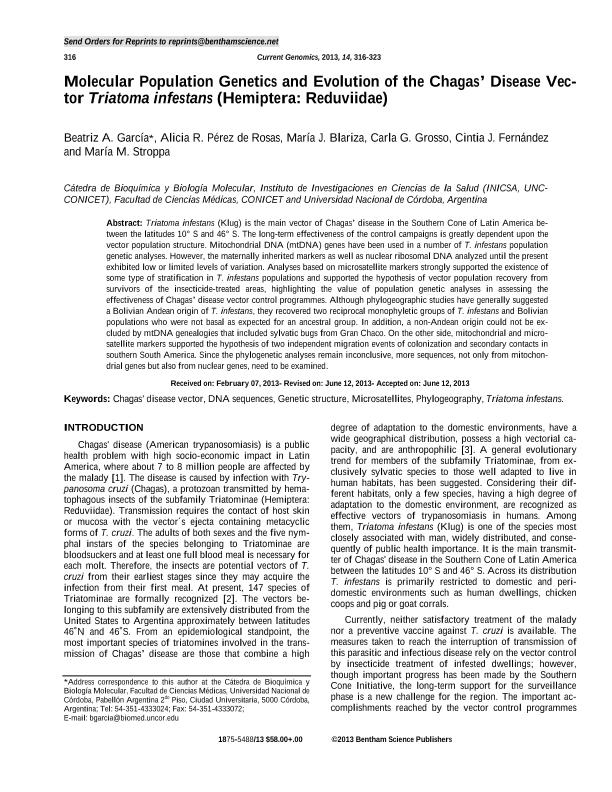Mostrar el registro sencillo del ítem
dc.contributor.author
Garcia, Beatriz Alicia

dc.contributor.author
Perez de Rosas, Alicia Raquel

dc.contributor.author
Blariza, María José

dc.contributor.author
Grosso, Carla Gisela

dc.contributor.author
Fernandez, Cintia Judith

dc.contributor.author
Stroppa, Maria Mercedes

dc.date.available
2017-01-17T20:52:06Z
dc.date.issued
2013-06
dc.identifier.citation
Garcia, Beatriz Alicia; Perez de Rosas, Alicia Raquel; Blariza, María José; Grosso, Carla Gisela; Fernandez, Cintia Judith; et al.; Molecular Population Genetics and Evolution of the Chagas’ Disease Vector Triatoma infestans (Hemiptera: Reduviidae); Bentham Science Publishers; Current Genomics; 14; 5; 6-2013; 316 - 323
dc.identifier.issn
1389-2029
dc.identifier.uri
http://hdl.handle.net/11336/11512
dc.description.abstract
Triatoma infestans (Klug) is the main vector of Chagas’ disease in the Southern Cone of Latin America between the latitudes 10° S and 46° S. The long-term effectiveness of the control campaigns is greatly dependent upon the vector population structure. Mitochondrial DNA (mtDNA) genes have been used in a number of T. infestans population genetic analyses. However, the maternally inherited markers as well as nuclear ribosomal DNA analyzed until the present exhibited low or limited levels of variation. Analyses based on microsatellite markers strongly supported the existence of some type of stratification in T. infestans populations and supported the hypothesis of vector population recovery from survivors of the insecticide-treated areas, highlighting the value of population genetic analyses in assessing the effectiveness of Chagas’ disease vector control programmes. Although phylogeographic studies have generally suggested a Bolivian Andean origin of T. infestans, they recovered two reciprocal monophyletic groups of T. infestans and Bolivian populations who were not basal as expected for an ancestral group. In addition, a non-Andean origin could not be excluded by mtDNA genealogies that included sylvatic bugs from Gran Chaco. On the other side, mitochondrial and microsatellite markers supported the hypothesis of two independent migration events of colonization and secondary contacts in southern South America. Since the phylogenetic analyses remain inconclusive, more sequences, not only from mitochondrial genes but also from nuclear genes, need to be examined.
dc.format
application/pdf
dc.language.iso
eng
dc.publisher
Bentham Science Publishers

dc.rights
info:eu-repo/semantics/openAccess
dc.rights.uri
https://creativecommons.org/licenses/by-nc-sa/2.5/ar/
dc.subject
Chagas' Disease Vector
dc.subject
Dna Sequences
dc.subject
Genetic Structure
dc.subject
Microsatellites
dc.subject
Phylogeography
dc.subject
Triatoma Infestans
dc.subject.classification
Genética y Herencia

dc.subject.classification
Ciencias Biológicas

dc.subject.classification
CIENCIAS NATURALES Y EXACTAS

dc.title
Molecular Population Genetics and Evolution of the Chagas’ Disease Vector Triatoma infestans (Hemiptera: Reduviidae)
dc.type
info:eu-repo/semantics/article
dc.type
info:ar-repo/semantics/artículo
dc.type
info:eu-repo/semantics/publishedVersion
dc.date.updated
2017-01-13T19:47:49Z
dc.identifier.eissn
1875-5488
dc.journal.volume
14
dc.journal.number
5
dc.journal.pagination
316 - 323
dc.journal.pais
Emiratos Árabes Unidos

dc.journal.ciudad
Sharjah
dc.description.fil
Fil: Garcia, Beatriz Alicia. Consejo Nacional de Investigaciones Cientificas y Tecnicas. Centro Cientifico Tecnologico Cordoba. Instituto de Investigaciones en Ciencias de la Salud; Argentina. Universidad Nacional de Cordoba. Facultad de Medicina. Catedra de Bioquimica y Biologia Molecular; Argentina
dc.description.fil
Fil: Perez de Rosas, Alicia Raquel. Consejo Nacional de Investigaciones Cientificas y Tecnicas. Centro Cientifico Tecnologico Cordoba. Instituto de Investigaciones en Ciencias de la Salud; Argentina. Universidad Nacional de Cordoba. Facultad de Medicina. Catedra de Bioquimica y Biologia Molecular; Argentina
dc.description.fil
Fil: Blariza, María José. Consejo Nacional de Investigaciones Cientificas y Tecnicas. Centro Cientifico Tecnologico Cordoba. Instituto de Investigaciones en Ciencias de la Salud; Argentina. Universidad Nacional de Cordoba. Facultad de Medicina. Catedra de Bioquimica y Biologia Molecular; Argentina
dc.description.fil
Fil: Grosso, Carla Gisela. Consejo Nacional de Investigaciones Cientificas y Tecnicas. Centro Cientifico Tecnologico Cordoba. Instituto de Investigaciones en Ciencias de la Salud; Argentina. Universidad Nacional de Cordoba. Facultad de Medicina. Catedra de Bioquimica y Biologia Molecular; Argentina
dc.description.fil
Fil: Fernandez, Cintia Judith. Consejo Nacional de Investigaciones Cientificas y Tecnicas. Centro Cientifico Tecnologico Cordoba. Instituto de Investigaciones en Ciencias de la Salud; Argentina. Universidad Nacional de Cordoba. Facultad de Medicina. Catedra de Bioquimica y Biologia Molecular; Argentina
dc.description.fil
Fil: Stroppa, Maria Mercedes. Consejo Nacional de Investigaciones Cientificas y Tecnicas. Centro Cientifico Tecnologico Cordoba. Instituto de Investigaciones en Ciencias de la Salud; Argentina. Universidad Nacional de Cordoba. Facultad de Medicina. Catedra de Bioquimica y Biologia Molecular; Argentina
dc.journal.title
Current Genomics

dc.relation.alternativeid
info:eu-repo/semantics/altIdentifier/doi/http://dx.doi.org/10.2174/13892029113149990006
dc.relation.alternativeid
info:eu-repo/semantics/altIdentifier/url/http://www.eurekaselect.com/114025/article
Archivos asociados
